Here’s a riddle for you…What stands tall and proud, has many columns, and is the most honorable place in France to be buried? It’s le Panthéon, of course!
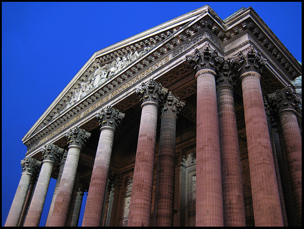
What the heck is a panthéon anyway? Good question! A panthéon is technically a temple, like the panthéon in Rome, in which le Panthéon was modeled after. For the French, the Panthéon is a sort of funeral “Hall of Fame”, housing the tombs of some of France’s greatest heroes.
The panthéon has an interesting history. It was first built as a church; then it was turned into a panthéon. Then it was turned back into a church, then back into a panthéon again! Are the French indecisive or what?
When to Go
The Panthéon is open year-round, so you can go whenever you darn well please!
The Panthéon is open from 10:00 to 6:00 pm.
Enjoy a different view of Paris from the top of the stairs anytime – and for free!
Cost
A visit to the Panthéon is €7,00 for adults.
Ages under 18 are free.
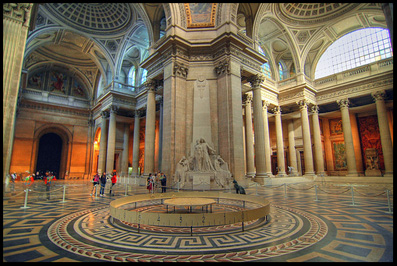
Photo by Philip Lai
History of le Panthéon
- In 1744, Louis XV was stricken with a mysterious disease. He vowed that if he recovered, he would build a church to replace the Abbaye de Ste-Geneviève.
- The king recovered and was so grateful to be alive that he built a church honoring Sainte Geneviève, patron saint of Paris.
- Architect Jacques-Germain Soufflot was hired for the job, and he designed the church in a neo-classical style. The interior has four isles arranged in the form of a Greek cross. It also has a dome, much like Saint Paul’s Cathedral in London.
- Work began on the church in 1764. Soufflot died before it was finished however, and his pupil Guillaume Rondelet carried out his work. The monument was completed in 1790, ten years after Soufflot’s death.
- After the revolution, the church was converted into a “Temple of Fame” – serving as a panthéon of great men. Both Mirabeau and Marat were temporary tenants there.
- In the 19th century, the building changed roles many times. In 1806, Napoléon turned it into a church. Eventually it was turned into a panthéon again, then back and forth, until it became a panthéon yet again in 1885, when Victor Hugo was buried there.
- Today, the monument houses the tombs of France’s greatest heroes. Men laid to rest there include Jean-Jacques Rousseau, Emile Zola, Louis Braille, Pierre Curie, Alexandre Dumas, André Malraux, and Voltaire.
- In 1995, the ashes of scientist Marie Curie were buried there, as the “first lady so honored in our history for her own merits” – Francois Mitterrand. (Another woman, Sophie Berthollet, was buried here first, alongside her chemist husband, Marcellin, but not as personal honor to her).
What to See
- The dome
- The façade
- The pendulum
- The paintings and sculptures
- The crypt and famous tombs
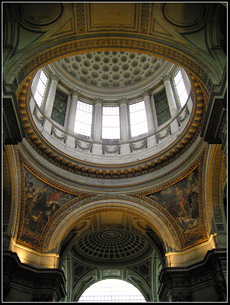
Photo by Casper Moller
In the dome of the Panthéon is a beautiful fresco representing the Glorification of Sainte Geneviève. It was commissioned by Napoléon in 1811. Take a guided tour and climb the 206 steps of the circular corridor beneath the dome for gorgeous panoramic views of the city 115 ft (35 m) above street level.
The façade of the Panthéon was inspired by the Rome panthéon – they look extremely similar with their columns and structure. Le Panthéon in Paris, however, has a triangular relief by David d’Angers towards the top of the building, depicting the mother country granting rest to her great heroes.
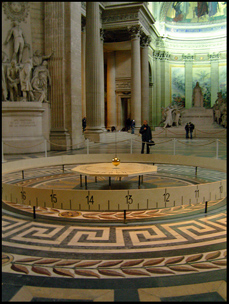
Photo by Casper Moller
Hanging from the dome is the pendulum, hung in 1851 by the scientist Léon Foucault. The Foucault pendulum was conceived as an experiment to demonstrate the rotation of the Earth. It is a sort of permanent exhibition in the Panthéon. The Panthéon also has many other exhibitions at various times. If you’re lucky, you’ll be there to see one!
The paintings and sculptures in the Panthéon are beautiful. The revolution is a common theme that is featured in numerous paintings and sculptures. In the naves of the building are many paintings with prominent religious heroes, such as Sainte Geneviève (of course), the beheaded Sainte Denis, Sainte Louis, and Jean of Arc.
The finest frescoes however, by Puvis de Chavannes, are at the end of the left wall before you enter the crypt. One illustrates Sainte Geneviève bringing supplies to relieve the victims of the famine. The best one depicts the patron saint with her white draped head looking out over a moonlit medieval Paris.
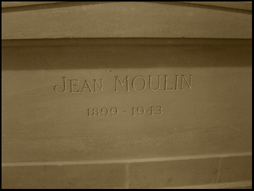
Photo by Casper Moller
Underneath the building, the vast crypt is divided into galleries bordered by columns.
The crypt houses many famous tombs. There are those of the writers: Victor Hugo, Emile Zola, and Voltaire; and those of the scientists: Marie and Pierre Curie. Then there is the tomb of Braille inventor Louis Braille, and World War II Resistance martyr Jean Moulin, an especially important figure to the French. Jean Moulin’s ashes were transferred to the Panthéon in 1964, and the speech given upon the transfer of his ashes is one of the most famous speeches in French history.